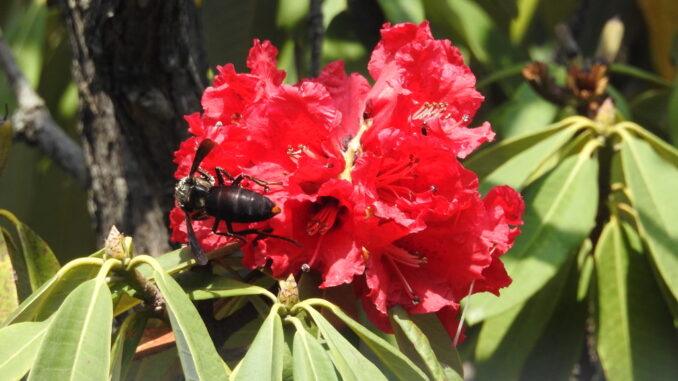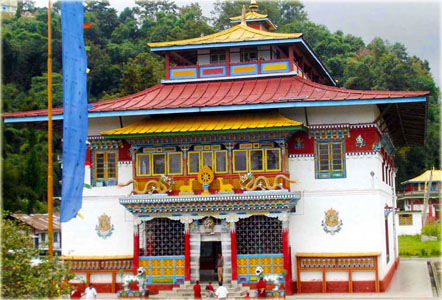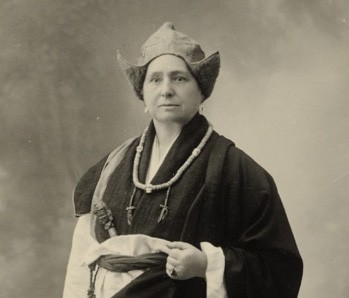
Alexandra David-Néel
Alexandra David-Néel is a woman I have never met. Yet, had it not been for her, I wouldn’t be caught dead in North Sikkim at the onset of winter. That too, alone, apart from my local guide. Certain journeys, though, are born from instinct, rather than desire. They are meant to be solitary in nature. So here I am, trekking up one of the region’s nameless mountains in search of a pair of caves with a fascinating history.
It is in one of them that Alexandra David-Néel, a late nineteenth-century-born French Buddhist scholar, explorer and author, had meditated for years. At a higher elevation lies the other, where her spiritual master, then Gomchen of Lachen Monastery, had spent thirteen years in self-imposed isolation for the same purpose.
This wild-looking tantric and reincarnate lama, a devotee of Guru Padmasambhava, would initiate his foreign disciple into advanced yogic practices. They included telepathy and the art of raising body heat to survive sub-zero temperatures. Skills that would, no doubt, stand David-Néel in good stead during her clandestine journey to the forbidden Tibetan capital of Lhasa in 1924.
Despite the remoteness of the caves – a local pilgrimage site – I’m not the first outsider to be drawn to them. Many have preceded me. Not curious tourists out for a lark, but dedicated researchers and Buddhist scholars from Europe. For them, Alexandra David-Néel, the first woman from the Western world to have set foot in Tibet, is no ordinary mortal. She is a revered icon.

“I vow to prove what the will of a woman can do.”
Unlike them, I had discovered her quite by chance through photographs and letters preserved in Phodong Monastery on the Gangtok – Mangan route. Intrigued by them, I had read up on the life of Alexandra David-Néel: her travels, her avid interest in “psychic forces”. And her bond with the then Prince of Sikkim, described as an enduring friendship by some, a love affair by others. This had ended with the death of the young royal in the “most suspicious circumstances”. This tragedy, along with other factors, would set the grief-stricken Alexandra David-Néel on her spiritual path.
Now retracing a part of the journey undertaken by this unusual woman whose heart lay in a world so far from her own, I concede how ill-equipped I am for such a venture. Standing near the Buddhist chorten we’ve reached after an arduous climb, I eye our next landmark. A mere speck in the distance. Somewhere behind it, at the end of a long, steep, strenuous ascent, lies the cave of David-Néel – a destination that looks more elusive than ever.
The Frenchwoman’s words, dredged up from memory, haunt me: “I vow to prove what the will of a woman can do.”
Unlike hers, mine has no chance of winning admiration. But it has brought me to a Sikkimese mountain village perched at 15,000 feet above sea level, despite dodgy knees, vulnerability to high-altitude sickness and habitual lethargy. Steeling myself, I motion my guide to lead the way.

Yetis, deities and Himalayan tales
Tsewang, however, is lost in childhood memories. “When I was a boy of nine,” my guide muses, gazing at the upper reaches of the mountain we’ve been climbing, “I saw the migou”.
I stare incredulously at this Army veteran from Lachen, a tiny North Sikkim village an hour’s drive away. A battle-hardened toughie who had fought off the Chinese at Nathu La and survived a posting in militancy-affected Nagaland is actually claiming to have sighted the yeti – a creature whose very existence is usually laughed off! He seems dead serious, though. And soon, it becomes apparent that for him, as for many of his fellow Lachenpas, the yeti is not just real. It is held in awe as the “king of man”, the meaning of the Bhutia word they use to refer to this denizen of the deep snows.
Tsewang couldn’t have chosen a more appropriate setting for sharing such memories. Our trek through high-altitude terrain has brought us to Deuthang, a village about 15,000 feet above sea level. The sub-zero November chill is numbing and dense clouds bear down on the snow-powdered mountains across the valley to our right. The herders living here have already descended with their livestock to lower altitudes for the duration of the harsh winter and their stone huts lie shuttered.
My laboured breathing sounds unnaturally loud in the silence that fills the desolation all the way from the road below and past Kalep, another village along our trek route that’s deep in hibernation till spring. Despite the gurgling streams we’ve crossed, the pervasive scent of junipers and the white starbursts of edelweiss in bloom – startling in an area that’s worlds away from The Sound of Music – there’s an eerie feel about this place that tends to lend legitimacy to local tales of demons and shamans and flying lamas.
Deuthang Valley
Sprawling far below us to our right is the Deuthang Valley, patterned by the strands of a jade green river. This feeds the sinister-looking Am Tso Nak, a “black lake” believed to be inhabited by a foul-tempered deity – half-canine, half-human – who vents his ire in strange ways. In this land, so remote that even place names frustrate Internet searches, pre-Buddhist traditions of nature worship survive. History is woven with myths and mysteries. A willing suspension of disbelief is a natural state of mind; everything seems to lie within the realms of possibility. Even the yeti.
No wonder the image my guide conjures up of a “giant nearly twice as tall as a man, with a face as dark as charcoal and fur the colour of silver”, standing high on a ridge overlooking Lachen, then a sparsely populated mountain village, is hard to shrug off. As is his enthralling account of the yeti descending during particularly severe winters from its home in the frozen heights to forage for food around the village at night. I’m anticipating chilling tales of close encounters, of mauling and death, but there are none. However, as with gods and sages, familiarity is discouraged.
“Never answer the migou’s call,” Tsewang cautions, recalling the advice of his village elders. “If you do, he will find you.”
He mimics the call – a low whistle.
In the silence that follows, I freeze; I’ve heard a faint response – the distant neigh of a horse. Tossing its unruly mane, the lonely animal is craning its neck to catch our eye from its enclosure on a high ridge to the left. Eager for company, it begins descending the tortuously winding path at a joyful trot, then startled, gallops off in another direction. It has discovered we’re strangers.
Alexandra David-Néel’s cave
It turns out that this solitary horse is one of several available for hire in summer, when the villagers are in residence. If only I had known, I tell Tsewang. In the absence of a mount, the challenge I’ve set myself today – to hike up to the first of the two caves, that of Alexandra David-Néel – is an increasingly daunting one.
Nature, however, has other plans.
“Madam, it’s snowing,” Tsewang announces, pointing to the snowflakes I hadn’t noticed, now drifting around us like miniature butterflies. “We must go back. In the mountains, you never know. Things can get tricky. We don’t take chances.”
In summer, he assures me, it will be much easier. “There will be horses, then. Also, flowers in bloom – rhododendron, primula, wild blue poppy…”

My heart swells with optimism.
But several days later, as I head for Bagdogra airport to catch my flight back to Kolkata, I remember that summer arrives in June in the state’s high-altitude areas. And lasts for a couple of months during which other parts of Sikkim are being ravaged by rain-triggered landslides. Vital roads are damaged or cut off, isolating much of the north from the world. Getting there in summer would be near impossible.
If not summer, then spring? Eagerly, I ask my taxi driver, an East Sikkim man, for his feedback on springtime in the north. Norbu, however, has a different take on the subject.
Himalayan Viagra or catterpillar fungus
“That’s the season for the northerner’s secret treasure hunt, madam,” he says. “As the snow begins to melt in the high-altitude meadows bordering Tibet, villagers from Lachen, Lachung and nearby areas climb up to collect the Yarcha Gyunbuk. It’s a caterpillar fungus from which traditional medicines are made for treating ailments ranging from diabetes to cancer. Those caught are arrested. But it’s worth the risk, because the fungus sells for lakhs of rupees, even in the domestic market. You must have noticed how prosperous those northerners are? Almost every household has a car. Where do you think the money comes from?”
I speculate half-seriously if the wonder worm has any connection with the yeti’s incredible strength or with David-Néel’s legendary powers of endurance. And text Tsewang right away, surprised that he hadn’t shared such interesting information with me. He confirms the story about the Yarcha Gyunbuk, but refutes the allegation that the trade is an illicit one. They’re just dead caterpillars, he texts back.
Surfing the Net later, I discover the caterpillar fungus anew, complete with its Latin name: Cordyceps sinensis. The reason for its astronomical price – anywhere from $2,000 to $20,000 per kg on the international black market, becomes clear. Famously known as the “Himalayan Viagra”, the fungus contains a steroid, believed to boost stamina and enhance athletic and sexual performance to an extraordinary degree. Significantly, it also goes undetected during dope tests.
You never know….
I also learn that government permission is mandatory for its collection. Fierce competition between smugglers, some from the Tibet Autonomous Region, laying claim to the same territory, has resulted in violent brawls and even murder. Although the state government is seeking to regulate the trade, conflicts are likely to escalate. Overharvesting and global warming are leading to depleting supplies.
It saddens me to discover the real world of human need and greed encroaching steadily on this land so close to my heart. Sikkim has always been known for its natural beauty and ancient folklore, its mysticism and its hardy, honest, endearing people.
Not long afterwards, I come upon a blog by a young tourist from the West. She has posted her photos of a home in Lachen that I recognize instantly. One of those pictures features a glass jar displaying a single caterpillar fungus. Another is a shot of the prized trophy’s proud owner – Tsewang.
“In the mountains,” he had warned, “you never know…”
(A slightly different version of this story was published in Hindu Business Line on January 04, 2019)

Landed here by chance and it is a wonderful read. i haven’t been to Sikkim or the north east, yet. So adding to the bucket list. I am an avid traveller myself, mostly international, to complete a bucket list created when I was 15.
Only 2 things remain: Mt. St. Helens in Seattle and Smithsonian in Washington. How was I supposed to know, 1980, that there were 2 Washingtons?
such a great storyteller, mita! you had me hooked. i had read this before leaving for my second voyage to sikkim, a land very very close to my heart, and read it today after returning to refresh my memory and indulge in the nostalgia of it all. its mystery pulls me to it, always. thanks for the fantastic write-up!